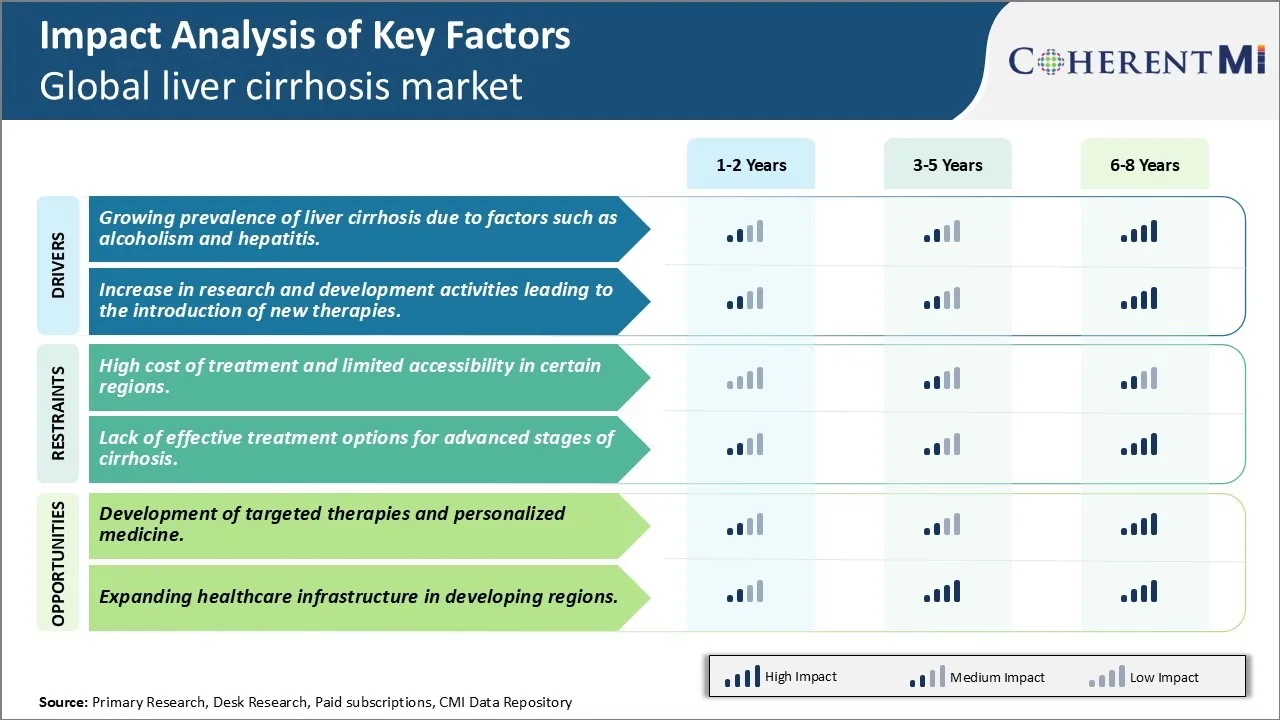Liver Cirrhosis Market Trends
Market Driver - Growing prevalence of liver cirrhosis due to factors such as alcoholism and hepatitis.
One of the key factors driving growth in the global liver cirrhosis market is the growing prevalence of the disease due to conditions such as alcoholism and viral hepatitis infections. Liver cirrhosis has been on the rise steadily over the past few decades due to increasing consumption of alcohol worldwide. Excessive consumption of alcohol over a long period of time can result in damage to liver cells and progression to advanced fibrosis and scarring of the liver or cirrhosis. This is one of the leading causes of liver cirrhosis globally, especially in developed Western nations. According to reports, an estimated 30% of cirrhosis cases in Europe and the United States are attributable to alcoholism. The steady rise in alcoholism cases being witnessed across both developed and developing countries is thus fueling the prevalence of alcohol-induced liver cirrhosis over time.
Similarly, viral hepatitis infections especially by hepatitis B (HBV) and hepatitis C (HCV) viruses are significant risk factors for cirrhosis development. An estimated 35 million to 150 million people worldwide are chronically infected with HCV, out of which 15-30% ultimately develop liver cirrhosis if not treated. Though vaccination programs have reduced HBV prevalence over the decades, HBV still remains endemic in many parts of Asia Pacific and Africa. This translates into large pools of populations at risk of developing chronic liver diseases including cirrhosis in the long run. The growing economic burden of viral hepatitis in terms of both human suffering and healthcare expenditures is thus supporting robust growth opportunities for players in the liver cirrhosis market.
Overall, the lack of awareness, challenges in diagnosis, and poor healthcare access in developing nations have meant that the number of people suffering from alcoholism and hepatitis continues to remain high globally. Unless effective preventive measures and treatment options are rolled out widely, this will sustain a consistent rise in prevalence of end-stage liver conditions such as cirrhosis over the forthcoming years, fuelling steady demand for drugs, devices and other therapeutics.
Increase in research and development activities leading to introduction of new therapies
Another key factor driving growth in the liver cirrhosis market is the substantial rise in investments toward research and development activities focused on this disease area over the past decade. This has successfully accelerated the introduction of innovative new drug molecules, medical devices and therapies that have enhanced treatment outcomes for cirrhosis patients.
Drug development programs have led to the approval and commercialization of several new generation anti-fibrotic molecules that directly target the underlying scarring process in cirrhosis. These include experimental anti-TGFβ compounds and proteases inhibitors among others that have delivered promising results in reducing progression to overt cirrhosis in clinical trials. Increased understanding of the molecular pathways involved in fibrosis regression has also facilitated the design of more targeted therapeutics. Medical technologies have advanced as well, with introduction of novel non-invasive devices for liver fibrosis assessment as well as improved transplantation techniques and post-surgery care protocols.
Additionally, the cell and gene therapy landscape related to liver diseases is rapidly evolving. Promising clinical trials have evaluated regenerative potential of stem cells, gene silencing strategies and gene therapy viruses towards reversing cirrhosis-induced damage. Though still preliminary, these novel regenerative modalities hold great future potential for curing end-stage liver conditions in the post. Overall, intense R&D activity in both pharmaceutical and device arenas have revitalized product pipelines, boosted approvals, and reshaped clinical practices, driving continual upgrades across the liver cirrhosis therapeutics space.
Looking forward, researchers and industry players are working collaboratively on newer molecular candidates and combination regimens targeting multiple fibrotic pathways simultaneously. Advances in AI, 3D tissue modelling and individualized medicine also promise more personalized therapies. Greater emphasis on R&D will thus remain crucial to sustain the

Market Challenge - High cost of treatment and limited accessibility in certain regions.
One of the major challenges currently faced by the global liver cirrhosis market is the high cost of treatment coupled with limited accessibility of advanced treatment options in certain parts of the world. Treating liver cirrhosis poses a huge financial burden especially in developing countries where healthcare budget and insurance coverage for such diseases is limited. The average annual cost of treatment varies significantly depending on the stage and severity of the disease, but can easily run into tens of thousands of dollars per patient. Even developed countries face challenges in providing universal insurance coverage and treatment access for such costly long term conditions. Furthermore, advanced treatment modalities such as liver transplantation are still not widely available in remote and underdeveloped regions due to lack of required infrastructure and trained medical professionals. This treatment gap is further exacerbated in low income populations within developing countries. Unless new and more affordable treatment alternatives are developed, high treatment costs will continue restricting timely and optimal management of liver cirrhosis globally.
Market Opportunity: Development of targeted therapies and personalized medicine
One of the major opportunities in the global liver cirrhosis market lies in the development of targeted therapies and personalized medicine approaches. Current standard of care relies on broad mechanisms to reduce liver inflammation and progression of scarring, but future therapies could target specific molecular pathways driving individual cases. This offers the possibility of developing tailored treatment protocols based on unique patient and disease characteristics such as genotype, stage of disease, co-morbidities etc. Several targeted drugs focusing on key mechanisms such as TGF-beta inhibition are under research. Emerging areas such as RNA therapeutics, gene therapy and regenerative medicine hold promise for delivering curative alternatives. With advances in biomarker discovery, non-invasive diagnostics and big data analytics, liver diseases can increasingly be managed through a personalized precision medicine approach. This could help optimize treatment response while limiting safety risks and costs through individualized protocols.